Togo -- 2007 Article IV Consultation, Concluding Statement of the IMF Mission
March 16, 2007
Describes the preliminary findings of IMF staff at the conclusion of certain missions (official staff visits, in most cases to member countries). Missions are undertaken as part of regular (usually annual) consultations under Article IV of the IMF's Articles of Agreement, in the context of a request to use IMF resources (borrow from the IMF), as part of discussions of staff monitored programs, and as part of other staff reviews of economic developments.
1. An IMF staff team visited Togo during February 28-March 13, 2007 to conduct the 2007 Article IV consultation discussions and review performance under the Staff-Monitored Program. The Article IV discussions focused on a medium-term reform strategy aimed at raising economic growth and moving toward fiscal and external sustainability. The mission also discussed policy measures to mitigate near-term macroeconomic risks and facilitate reengagement with the donor community.
I. Recent Economic Developments and Outlook
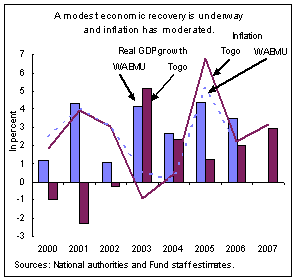 |
2. A modest economic recovery is underway, with real GDP growth of 2 percent in 2006 and projected at 3 percent for 2007. After the recession in 2005, real GDP in 2006 growth was driven by services related to regional trade, which helped offset the drag on growth caused by the crisis in the cotton sector. For 2007, growth is expected to be driven by higher public investment and a rebound in cotton production. Inflation, after spiking in 2005, fell to only 2¼ percent in 2006, but buoyant money growth could contribute to a small rebound in inflation in 2007. The current account deficit rose to about 6 percent of GDP in 2006, reflecting higher oil prices and lower cotton exports, and is expected to stabilize at this level in 2007. External competitiveness has been hampered by the appreciation of the euro (and thus the CFA franc) against the U.S. dollar, the rise in oil prices, and weakening export prices.
3. Fiscal policy implementation improved in the second half of 2006. The primary deficit in 2006, equivalent to 1 percent of GDP, was slightly higher than envisaged in the budget, partly due to large discretionary expenditures through offbudget and exceptional procedures in the first half of the year. The government curtailed these procedures in the second half and was able to halt the accumulation of domestic arrears, for the first time in years. Revenue collection was very strong, partly reflecting reforms in the tax and customs administration as well as a large exceptional profit transfer from the BCEAO in late 2006. Arrears to external creditors continued to build rapidly, however, reflecting an unsustainably high external debt burden. The proceeds from the February 2006 regional bond issue were used to boost investment and reduce domestic arrears, including to civil servants and cotton farmers. Spending commitments and payment authorizations were closed in end-November and end-December 2006, respectively, for the first time in years.
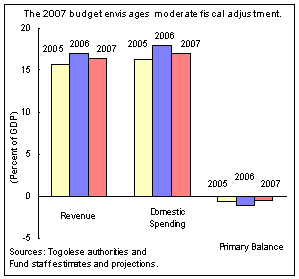
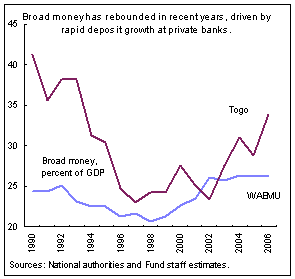
4. The 2007 budget provides an anchor for macroeconomic stability in an election year, with an envisaged reduction in the primary fiscal deficit to ½ percent of GDP. The fiscal adjustment is supported by measures to support revenue collection through further administration reforms, including tax audits and computerization of customs. This is expected to yield revenues of 16½ percent of GDP in 2007, which is broadly in line with 2006 controlling for the one-off BCEAO profit transfer and tax arrears recovery in 2006. A central reform objective for this year is to minimize exceptional spending procedures and improve monitoring of budget execution, with the aim of better controlling discretionary spending. This would allow reducing nonpriority spending and increasing spending on health, education, and public infrastructure as envisaged in the 2007 budget.
5. Broad money growth accelerated to 22 percent in the twelve months to December 2006, despite the continued difficulties of several banks. Both cash in circulation and bank deposits grew very rapidly, driven by a sharp increase in remittances from abroad and by short-term capital inflows related to regional trade. A number of banks are undercapitalized and severely burdened by nonperforming loans, including to the state-owned cotton and phosphate companies. The Togolese authorities and the WAEMU banking commission have made significant progress in preparing a restructuring strategy, with the support of IMF technical assistance.
II. Key Economic Challenges
6. Togo's key near-term economic challenges are to mitigate macroeconomic risks and set the conditions for broader economic reforms. Specifically, the mission recommended that the authorities focus on:
• Containing fiscal pressures in the run-up to the parliamentary elections, planned for mid-2007, to meet the 2007 budget targets and avoid renewed accumulation of domestic arrears. This will require progress in eliminating exceptional spending procedures, improving expenditure monitoring, and further strengthening revenue administration.
• Monitoring closely the factors driving money growth, potential price pressures, and the ability of the local banking sector to absorb the recent surge in liquidity.
• Implementing priority structural reforms to restore confidence and help sustain the recent economic recovery. Key steps include audits of public enterprises and domestic debt, the reimbursement of cotton farmers, and strengthening the financial position of banks.
• Reengaging with the donor community to support the rehabilitation of social services, public infrastructure, and institutional capacity. This will require finalizing the I-PRSP update and addressing arrears to multilateral organizations.
7. The central medium-term challenge is to sustain higher economic growth after 25 years of per capita income decline. The authorities are in the process of formulating a broad-based economic reform program aimed at improving living standards. The mission welcomed this effort and underlined the importance of:
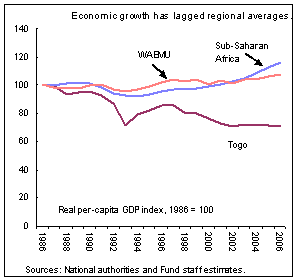 |
• Strengthening fiscal governance and public finances, which are burdened by weak expenditure control, high public debt, and low external assistance.
• Raising economic productivity, which is constrained by weak public infrastructure (especially energy), insufficient resources for health and education, a poor business environment, and more generally weak institutions.
• Containing the current account deficit to avoid exposure to short-term capital inflows and mitigate risks of potential external shocks.
III. Developing a Medium-term Economic Reform Strategy
8. Sustaining higher economic growth will require a coherent economic reform strategy and increased external assistance. Economic reforms will be critical for: (i) reversing the decline in living standards; (ii) meeting 2007 budget targets; (iii) preventing renewed arrears accumulation; (iv) reducing public debt to a sustainable level; (v) reducing the economy's vulnerability to financial and external shocks; and (vi) improving public institutions and human development indicators.
9. The authorities discussed with the mission the broad outlines of a growth-oriented reform strategy. The government is updating the 2004 interim Poverty Reduction and Growth Strategy Paper (I-PRSP) and has completed a poverty survey. The I-PRSP outlines the sources and constraints to growth and identifies policies and projects to support higher economic growth through: (i) strengthening of public finances and fiscal governance; (ii) improvements in the business environment; (iii) financial sector development; (iv) agricultural reform; (v) better access to health and education; and (vi) rehabilitation of public infrastructure, especially electricity, water, and transport. The authorities have identified a preliminary set of priority reforms and cost estimates and discussed a medium-term macroeconomic framework with the mission.
10. Improving public finances and fiscal governance will be critical to reconcile spending needs within a limited resource envelope. The mission recommended raising the primary fiscal balance to a surplus of at least ¾ percent of GDP by 2010 to avoid running new arrears and limiting the need for new borrowing. The fiscal adjustment could be achieved by gradually raising fiscal revenues to about 18 percent of GDP, supported by continued reforms to strengthen revenue administration and to simplify and streamline the tax and customs codes. Future budgets should identify savings in nonpriority outlays to make room for spending on institution building, restructuring of state-owned banks and enterprises, and cofinancing of donor-funded projects on health, education, and public investment. This will require strong measures to strengthen fiscal governance through improved expenditure monitoring, planning, and control.
11. Higher external assistance and comprehensive debt relief under the HIPC initiative are needed to support Togo's economic reform strategy. The decade-long disengagement from donors has weakened the state's institutional capacity, constrained the provision of education and health, and severely eroded the quality of public infrastructure. Reaching the Millennium Development Goals (MDGs) would require far more external aid than the authorities are expecting. Even with the more limited goal of raising foreign-financed social and investment spending to the regional average, Togo would need to identify three times as much annual foreign assistance as was available in 2006. This would require timely completion of the I-PRSP and efforts to upgrade public financial management. Financing assurances from donors, successful performance under the SMP, and an identified mechanism for arrears clearance with external creditors would help Togo move toward a PRGF arrangement with the IMF, which in turn could pave the way for debt relief under the HIPC initiative and MDRI.
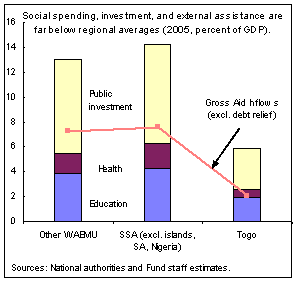
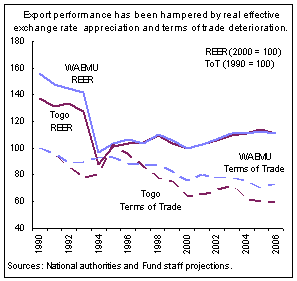
12. External competitiveness has been eroded by both structural factors and changes in relative prices. Adverse terms of trade developments and real exchange rate appreciation since the 1994 devaluation have contributed to weak economic growth, low exports, and a large current account deficit. The CFA franc is not considered to be significantly misaligned at this point for the WAEMU region as a whole, and Togo's real exchange rate has followed the regional average closely in recent years. However, Togo's external competitiveness is hampered significantly by adverse terms of trade, a poor business environment, and daily electricity and telecommunication outages.
13. The mission recommended relying on fiscal adjustment and structural reforms to boost economic growth and external competitiveness within the existing exchange rate regime. Togo's membership in the regional currency union (WAMU) has been an anchor for macroeconomic stability, with significant benefits in terms of low inflation and access to regional markets. Despite recent real exchange rate appreciation, wages in Togo are still comparatively low, and the policy focus should thus be on raising productivity growth with the aim of strengthening external competitiveness. Fiscal policies can support this objective by raising revenues and reallocating spending in favor of education, health, and public investment. This should be complemented by improvements to the broader business environment, development of the financial sector, and reform of state-owned enterprises and agriculture. These reforms could support private sector growth and inflows of foreign direct investment, laying the foundation for future export and productivity growth.
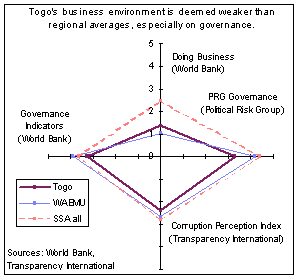 |
14. A key reform priority is to improve the business environment to support private sector-led growth and foreign investment. International surveys show that Togo's business environment is deemed very poor, even by the low regional standards, in particular on governance-related indicators. The authorities stressed that continuing the process of national reconciliation and political reform will be critical to make Togo more attractive as an investment destination. The mission added that the authorities should also consider steps to: (i) reduce barriers to trade, services, and investment; (ii) streamline and simplify the tax and customs codes; and (iii) strengthen governance by combating corruption, improving the judiciary, strengthening property rights, raising transparency of public institutions, and cutting red tape, including by setting up a one-stop shop. There was agreement that strengthening institutional capacity is critical in this context, requiring technical assistance from donors.
15. The mission reviewed the government's plans to reform state-owned enterprises, including in the cotton, phosphate, and electricity sectors. It stressed that reforms will be critical both for reviving growth and mitigating risks of spillovers to the budget.
• The mission commended the authorities for the phased repayment of arrears to cotton farmers, which could help restore confidence in the sector. The authorities have stated that they will take strong measures to strengthen financial controls, following the financial audit of SOTOCO, and use the results of the strategic audit to initiate broader reforms of the cotton sector. The mission stressed that diversification into other agricultural crops will be important to set the conditions for sustained economic growth.
• The authorities are preparing a financial and strategic audit for the phosphate sector. Production is expected to increase modestly in 2007, but a full recovery of the sector would require resolving legal disputes and attracting a strong strategic investor.
• Electricity supply has been severely disrupted by a sharp decline in energy imports from Ghana and Côte d'Ivoire and higher costs of local production. Given the potential risk of spillovers to the budget and the negative impact on the investment climate, the mission urged authorities to monitor the financial position of these enterprises regularly and work with development partners on options for a medium-term sectoral reform strategy.
16. The mission welcomed the recent progress on preparing a comprehensive strategy for strengthening the financial sector. The authorities are working closely with the WAMU Banking Commission to strengthen several banks, with the support of a recent IMF technical assistance mission. The authorities stressed that the intention is to privatize most of the state-owned banks. Additional measures to support financial sector development include: (i) improvements to the legal environment to facilitate registration of property and recovery of loans; (ii) facilitation of microfinance to enhance access to credit by SMEs and households; and (iii) deepening of the primary and secondary bond market.
17. The authorities' medium-term reform program has the potential to raise economic growth significantly. This should help to improve social conditions, reduce poverty, and make progress toward the MDGs. After a decade of disengagement, external assistance must play a key role in reviving growth and rebuilding institutions. However, the authorities and the mission agreed that domestic reforms are ultimately the key for relaunching and sustaining private sector-led economic growth.
18. The mission would like to thank the authorities for their hospitality and the very constructive discussions.
| Togo: Selected Economic and Financial Indicators, 2003-2007 | |||||
| 2003 | 2004 | 2005 | 2006 | 2007 | |
| Actual |
Program 1 |
||||
| (Percent change, unless otherwise indicated) | |||||
|
National income, prices, and exchange rates |
|||||
|
Real GDP |
5.2 | 2.3 | 1.2 | 2.0 | 2.9 |
|
Real GDP per capita |
2.4 | -0.3 | -1.3 | -0.5 | 0.4 |
|
GDP deflator |
-9.9 | 2.8 | 7.4 | 2.1 | 2.0 |
|
Consumer price index (annual average) |
-0.9 | 0.4 | 6.8 | 2.2 | 3.2 |
|
GDP (CFAF billions) |
972.7 | 1,023.3 | 1,112.7 | 1,158.8 | 1,216.3 |
|
Exchange rate CFAF/US$ (annual average) |
580.1 | 527.5 | 527.0 | 524.4 | ... |
|
Real effective exchange rate (annual average) |
3.7 | 1.1 | 2.5 | ... | ... |
|
Terms of trade (deterioration _) |
3.7 | -12.2 | -3.9 | -2.8 | ... |
|
Monetary survey |
|||||
|
Net foreign assets 2 |
0.6 | 27.0 | -2.8 | 23.2 | ... |
|
Credit to government 2 |
-7.4 | -3.6 | -1.2 | 0.1 | ... |
|
Credit to the nongovernment sector 2 |
16.1 | 2.8 | 6.6 | 0.0 | ... |
|
Broad money (M2) |
11.4 | 18.3 | 1.4 | 22.1 | ... |
|
Velocity (GDP/ end-of-period M2) |
3.6 | 3.2 | 3.5 | 3.0 | ... |
| (In percent of GDP, unless otherwise indicated) | |||||
|
Investment and savings |
|||||
|
Gross domestic investment |
10.8 | 11.1 | 12.4 | 13.5 | 14.4 |
|
Government |
1.1 | 1.5 | 3.3 | 4.1 | 4.3 |
|
Nongovernment |
9.8 | 9.5 | 9.1 | 9.4 | 10.1 |
|
Gross national savings |
7.2 | 9.6 | 6.6 | 7.1 | 7.8 |
|
Government |
3.5 | 2.5 | 0.9 | 1.3 | 1.5 |
|
Nongovernment |
3.7 | 7.1 | 5.8 | 5.8 | 6.3 |
|
Government budget |
|||||
|
Total revenue and grants |
17.6 | 17.5 | 16.9 | 18.3 | 19.0 |
|
Revenue |
17.0 | 16.8 | 15.7 | 16.9 | 16.5 |
|
Total expenditure and net lending |
15.1 | 16.6 | 19.3 | 21.1 | 21.9 |
|
Domestic primary expenditure |
12.5 | 13.6 | 16.2 | 18.0 | 16.9 |
|
Overall balance (payment order basis) |
2.4 | 1.0 | -2.4 | -2.8 | -2.8 |
|
Primary balance ³ |
4.5 | 3.2 | -0.5 | -1.1 | -0.4 |
|
Change in domestic arrears |
0.3 | 0.5 | 1.9 | -0.4 | 0.0 |
|
External sector |
|||||
|
Current account balance |
-3.7 | -1.5 | -5.7 | -6.4 | -6.6 |
|
Exports (goods and services) |
43.3 | 41.2 | 39.8 | 40.5 | 40.4 |
|
Imports (goods and services) |
57.3 | 56.2 | 57.6 | 60.2 | 60.4 |
|
External public debt |
93.3 | 86.2 | 88.0 | 80.5 | ... |
|
Of which: arrears |
25.7 | 24.3 | 25.8 | 25.6 | ... |
|
External public debt service (percent of exports) |
17.9 | 16.9 | 11.4 | 11.2 | 13.0 |
|
Gross international reserves, months of imports (G&S) |
2.3 | 3.6 | 2.0 | 3.2 | 3.0 |
|
Sources: Togolese authorities; and Fund staff estimates and projections |
|||||
|
¹ Program for 2006 and 2007 reflect SMP objectives; reform scenario; and the 2007 budget. |
|||||
|
² In percent of broad money at the beginning of the period. |
|||||
|
³ Revenue minus expenditure, excluding grants, interest payments, and foreign-financed expenditure. |
|||||
IMF EXTERNAL RELATIONS DEPARTMENT
| Public Affairs | Media Relations | |||
|---|---|---|---|---|
| E-mail: | publicaffairs@imf.org | E-mail: | media@imf.org | |
| Fax: | 202-623-6220 | Phone: | 202-623-7100 | |







